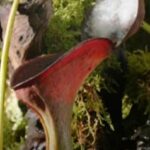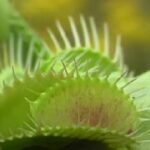As an Amazon Associate, this site earns commissions from qualifying purchases. For more details, click here.
Carnivorous plants use insects as food primarily to supplement their nutrient intake, not as their main source of energy. Like all green plants, carnivorous plants perform photosynthesis, using sunlight, water, and carbon dioxide to produce their own energy (sugars).
Life in Poor Soil – The Unlikely Beginning
At first glance, lush greenery often suggests fertile soil, but carnivorous plants flip that assumption on its head. Most of them don’t grow in rich, dark earth teeming with nutrients — they thrive in some of the most unforgiving environments on the planet. Acidic bogs, sandy barrens, and tropical rainforests with nutrient-leached soils are their homes. What these habitats have in common is a surprising lack of nitrogen and phosphorus, two essential nutrients for plant growth.
In these nutrient-poor ecosystems, traditional root absorption doesn’t cut it. So rather than die out, some plants evolved to look elsewhere — and “elsewhere” turned out to be above ground: crawling, buzzing, flying creatures. Insects and other small animals became an unlikely but effective nutritional supplement.
This adaptation shows nature’s incredible inventiveness. Instead of relying solely on what the soil provides, these plants turned to a resource their competitors ignored — and they did it not through speed or mobility, but through patience and ingenuity.
Ready to Grow Carnivorous Plants with Confidence?
Stop guessing and start thriving. Whether you’re raising flytraps, sundews, Nepenthes, or butterworts, this visual-first guide gives you everything you need — from lighting and watering to feeding and seasonal care.
- Beginner-proof diagrams
- Step-by-step routines
- Instant PDF download

Evolution’s Clever Detour
The decision (if we can call it that) to eat animals didn’t happen overnight. Over millions of years, different plant species facing similar challenges evolved similar solutions. This is a process scientists call convergent evolution — when unrelated organisms independently develop similar traits to solve the same problem.
What’s fascinating is how many times carnivory has evolved separately in the plant kingdom. It didn’t happen once and spread; it happened again and again in different families of plants, across different continents. That suggests that the “insect-eating strategy” is a powerful evolutionary tool — especially in extreme conditions where nutrients are scarce and competition is fierce.
This also shows us that evolution isn’t always about bigger, faster, or stronger. Sometimes, it’s about being smarter — or sneakier.
Plants That Hunt – Not So Passive After All
We tend to think of plants as static background scenery, just standing there photosynthesizing. But carnivorous plants challenge that idea dramatically. These are green beings that sense, move, attract, and even digest. They blur the boundary between what we think of as “plant-like” and “animal-like” behavior.
Take the Venus flytrap — it can count. Yes, really. Its trap won’t snap shut on the first touch. It waits for a second signal, ensuring that what triggered it is a real insect and not, say, a raindrop. That’s not just a clever mechanism — it’s energy-efficient decision-making.
The sundew uses sticky tentacles that slowly bend toward struggling prey, while pitcher plants turn their leaves into slippery death traps that drown insects in digestive fluids. Each one has evolved its own sophisticated strategy for hunting — without eyes, muscles, or brains.
What’s remarkable is that these hunting techniques aren’t just survival strategies. They’re elegant, highly evolved solutions to a very specific problem — and they make us question just how passive the plant kingdom really is.
Tools of the Green Trade – How Plants Catch Prey
Carnivorous plants may look harmless, even beautiful. But behind their colors and curves lie deadly tricks refined by evolution. These plants don’t just wait for nutrients to appear — they set traps, lure victims, and digest them with precision. In this chapter, we explore how these botanical hunters pull off their remarkable feats.
Snap, Stick, and Slip – The Main Trapping Methods
Carnivorous plants use five primary strategies to catch prey, and each is like a masterpiece of evolutionary engineering.
- Snap Traps
The most famous example is the Venus flytrap (Dionaea muscipula). Its leaves are modified into jaw-like structures with trigger hairs inside. When an insect touches these hairs twice within about 20 seconds, the trap snaps shut in a fraction of a second. It’s a high-speed ambush, rivaling some animal reflexes. - Sticky Traps
The sundew (Drosera) is a gentler-looking killer. It has glistening tentacles tipped with mucilage — a sticky, sweet-smelling substance. When an insect lands, it gets glued in place. The tentacles then slowly curl around the struggling prey, eventually engulfing it. - Pitfall Traps
Pitcher plants turn their leaves into deep, slippery chambers. Lured by scent or nectar, insects venture inside — only to slide down the slick walls into a pool of digestive fluid. Some pitchers are so effective they can trap small frogs or even rodents. - Suction Traps
Bladderworts (Utricularia) grow in water and use tiny vacuum-sealed bladders. When prey touches hair-like triggers near the bladder opening, the door flies open and water rushes in — sucking the prey in faster than the blink of an eye. - Lobster-pot Traps
These are maze-like traps used by some plants like Genlisea (the corkscrew plant), guiding prey inward through narrow, twisting tunnels that are easy to enter but nearly impossible to escape.
Each method is tailored to the plant’s environment, prey type, and available resources — a quiet war strategy that works without movement or noise.
Lure and Deceive – Plant Trickery at Work
Before trapping comes the lure — and here, carnivorous plants use deception as a fine art.
- Color & Pattern: Many traps mimic flowers or fruit, using bright reds, purples, and UV patterns to attract curious insects. To a fly or beetle, a pitcher plant might look like a delicious bloom.
- Scent: Some pitcher plants emit sweet or fruity odors. Others release smells that mimic rotting organic matter, appealing to carrion-loving insects like flies.
- Nectar Bait: Secretions around trap openings reward insects just enough to draw them deeper in — until they slip, stick, or get snapped.
This deceptive signaling mirrors what flowers do to attract pollinators. But instead of a mutual benefit, the reward for the insect is a one-way trip. In fact, some plants both pollinate and kill insects, raising a curious dilemma: how do they avoid eating their own pollinators? The answer is often clever spatial separation — flowers above, traps below — or timing their blooming and hunting phases separately.
Digestive Magic – Turning Bug into Plant Food
Once the prey is trapped, the next step is digestion — and it’s more complex than you might think.
- Enzymes: Most carnivorous plants produce enzymes like proteases and phosphatases that break down the soft tissues of their prey. These enzymes dissolve proteins, releasing nitrogen, phosphorus, and other vital nutrients.
- Symbiotic Helpers: Some plants, especially large pitcher species, host symbiotic bacteria or tiny animals inside their traps. These organisms help decompose the prey, and in return, the plant absorbs the nutrients released from the process.
- Absorption Mechanism: Special cells on the inner trap surfaces absorb the digested fluid, just as roots absorb nutrients from soil. In essence, the plant has replaced part of its root function with a stomach-like chamber.
This feeding method is not about hunger in the traditional sense — the plant still photosynthesizes. Instead, it’s about survival in scarcity. In places where roots can’t find enough nourishment, leaves have stepped up to do the job.
Carnivorous plants are master strategists. They lure, trap, and digest prey with an elegance that seems almost intelligent — yet it’s all driven by structure, chemistry, and evolution. In the next chapter, we’ll explore what these strange behaviors tell us about the ecosystems they live in — and about life itself.
Beyond Survival – What Carnivorous Plants Teach Us
Carnivorous plants aren’t just botanical curiosities or freaks of nature — they are windows into how life adapts, innovates, and survives. In this final chapter, we explore how these plants interact with their ecosystems, what they reveal about evolution and resilience, and why they matter in today’s changing world.
Ecology of the Unusual – Their Role in the Food Web
Carnivorous plants may seem like top-tier predators in their micro-worlds, but they’re also part of a complex and delicate balance in the ecosystems they inhabit.
- Not Just Predators: While they consume insects, they also provide microhabitats. Some pitcher plants, for example, hold rainwater inside their traps, creating tiny aquatic ecosystems. These miniature ponds are home to insect larvae, frogs, and even small crabs that live without ever escaping the plant.
- Nutrient Cyclers: By digesting prey and absorbing nutrients, these plants help recycle scarce elements in nutrient-poor soils. In some cases, they even feed on decomposed plant matter, functioning as slow-motion composters.
- Food Source and Shelter: Ironically, some insects have evolved to live inside traps and avoid digestion. These commensal or mutualistic relationships are a marvel — certain mosquito larvae, for instance, live safely inside pitcher traps, feeding on decaying prey without harming the plant.
Far from being isolated freaks, carnivorous plants are deeply embedded in their habitats, serving both as predator and host in their specialized niches.
From Curiosity to Conservation
Humans have long been fascinated by carnivorous plants — from Victorian-era greenhouses to modern science labs, they’ve held a near-mythical allure.
- Scientific Curiosity: Charles Darwin himself was captivated by them. In fact, his book Insectivorous Plants was one of the first scientific studies of plant behavior, where he called the Venus flytrap “one of the most wonderful plants in the world.”
- Cultural Icon: Over time, these plants have inspired myths, horror stories, and films — sometimes exaggerated into man-eating monsters. But reality is more interesting than fiction.
- Under Threat: Today, many carnivorous plant species are endangered. Habitat destruction, pollution, poaching, and climate change are driving some to the brink. Bog drainage, in particular, has destroyed vast areas where these plants once thrived.
That makes conservation essential — not just because they’re rare or beautiful, but because they are living examples of how life finds a way under the harshest conditions.
Lessons from a Bug-Eating Plant
Carnivorous plants force us to rethink our categories: predator or prey, plant or animal, passive or active. They blur lines and challenge assumptions.
- Adaptability: These plants show that survival isn’t always about brute strength — sometimes, it’s about being clever in unexpected ways. They evolved a whole new way to feed when conditions made traditional growth strategies impossible.
- Innovation Through Constraint: Their environment didn’t offer much, but instead of giving up, they turned a limitation into an opportunity — a lesson that resonates far beyond botany.
- The Power of Patience: Carnivorous plants don’t chase, pounce, or sting. They wait. They conserve energy. And when the time is right, they act with precision. There’s a quiet power in their strategy — one that suggests a deeper kind of intelligence in the natural world.
In the end, carnivorous plants aren’t just survivors — they are reminders of how deeply adaptive, strange, and beautiful life can be when pushed to the edge.
Conclusion
From the nutrient-starved bogs of the world rise these improbable green hunters — elegant, deceptive, and efficient. They teach us about resilience, blur the boundaries of what we expect from nature, and invite us to look more closely at the hidden ingenuity all around us.

My fascination with carnivorous plants began many, many years ago with Venus Fly Traps. Now I am more than happy to impart what I know with other enthusiasts and those who are curious about meat eating plants.


